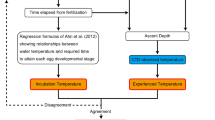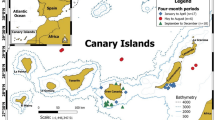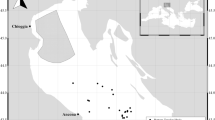Abstract
This study reports on the first observation of a spontaneously matured female European eel. The 43-year-old eel, together with eleven other females, resided at an aquarium house since their capture in 2002 and stocking as glass eels in 1978. In June 2019, the girth of the belly of the female increased as a sign of oocyte maturation. The specimen had an estimated gonadosomatic index (GSI) of 47, only half of the oocytes were hydrated and matured, indicating that European eels are polycyclic batch spawners. The live eels of the cohort were still in the previtellogenic phase but their eye sizes were close to that of the matured eel. We hypothesize that substances released by other maturing and spawning fishes may have triggered puberty of the eel. This first observation, and the possibility of more eels maturing in the near future, provides a natural reference for the sexual maturation of the European eel.
Similar content being viewed by others
Introduction
Eels of the genus Anguilla are characterized by a catadromous migration from continental fresh and brackish water habitats to, often remote, oceanic spawning grounds. Temperate eels swim the longest distances1, the European eel being the most extreme example, covering 5–6000 km to the Sargasso Sea2 in the northwest Atlantic Ocean. Eels exhibit semelparity and probably die soon after one or few subsequent spawning events in one spawning season3. In captivity, when the reproductive migration is prevented, eels do not spontaneously mature. Long-term hormonal stimulation by hypophysation is commonly practiced to mature eels artificially4. Until now, this has offered the only opportunity to observe fully mature European eels.
In this short article, we report on the first spontaneously matured European eel ever observed. This specimen, a 43-year-old female, was stocked in the Finnish Lake Vesijärvi as a glass eel from France in 1978. This eel was part of a cohort of twelve very large female eels that was re-captured in 2002 and that was then transferred to the Maretarium in Kotka, Finland. On June 12 2019, the girth of the eel’s belly had increased to reflect oocyte hydration that occurs during the final stage of sexual maturation. One month later, on July 13, the female died without having released any eggs. Other eels of the same cohort displayed large eyes and some ate little food, if anything at all – these are possible signs of commencement of puberty and hold promise of more eels maturing in the near future.
Methods
Aquarium environment
In 2002, the eels were introduced into a 600 m3 tank, but one year later they were transferred to a smaller 8.1 m3 tank. Both tanks received Baltic seawater that fluctuated over the season in temperature (8–18 °C), salinity (2.33–4.53 ppt), pH (7.1–8.5) and colour (15–35 mg Pt l−1). Specifically, water temperatures in the period January 1 2019 until the moment of death of the matured female on July 13 2019 increased from 8.4 to 16.9 °C with two small peaks occurring in March (supplemental material). The light regime depended on opening hours: 9.30–17.00 h (and 11.30–19.00 h on Wednesdays) from January to June and from September to January, and 9.30–19.00 from June to September. Sand and UV filtration were applied. Eels were fed Baltic herring (Clupea harengus membras; 70%) and sprat (Sprattus sprattus; 30%) but since February 2019 also shrimp (Pandalus borealis) and blue mussel (Mytilus chilensis). In the 8.1 m3 tank, the eels were kept together with pike (Esox lucius). Importantly, in February 2019, brown trout (Salmo trutta), common roach (Rutilus rutilus) and bream (Abramis brama) were introduced into the tank. Bream displayed a spawning rash ever since the introduction, but they never spawned. The tank was connected to the same recirculating aquaculture system as other tanks in which European perch (Perca fluviatilis), pike-perch (Sander lucioperca), Eurasian minnow (Phoxinus phoxinus), round goby (Neogobius melanostomus) and also river lamprey (Lampetra fluviatilis) spawned during the spring of 2019.
Measurements on the matured eel
When the eel had just died, on July 13 2019, she was weighed and photos were taken of an ovarian sample. The specimen was stored in the freezer and defrosted just prior to analysis on October 28 2019; the specimen was photographed, weighed and measured (total length, girth, eye diameters and pectoral fin length). Measures were used for calculations of the Fulton condition factor K, the eye index (EI5), body girth index (BGI6) and pectoral fin index (PFI7). Following dissection, ovary, liver, intestine and heart weights were determined to estimate somatic indices (organ weight relative to body weight times 100%), i.e., gonadosomatic index (GSI), hepatosomatic index (HSI), intestinal somatic index (ISI) and the cardiac somatic index (CSI). The swimbladder was examined for the presence of the swimbladder parasite Anguillicoloides crassus and otoliths were retrieved for age confirmation. One of the otoliths was grinded and etched with mild HCl dilution before dyeing in Neutral Red solution to amplify the visibility of the annuli.
Measurements on live eels
The live eels from the same cohort were anaesthetised (benzocaine, 80 ppm), weighed and measured as described above, and subjected to ultrasound examination for non-invasive estimation of GSI values8. Husbandry conditions (light/dark regime; water temperature, salinity, pH and colour; broodstock feeds and presence of other fish species maturing and reproducing) had been monitored and were considered as potential triggers of sexual maturation.
Ethics
The manipulations on live European eels were approved by the Dutch Central Committee for Animal Experimentation (CCD nr. AVD401002017817) and the Animal Experimental Committee of Wageningen University (IvD nr. 2017.D.0007.003) and were in keeping with the conditions in research permit STK543A, ESLH-2001–08613/Ym-21 issued to Kotka Maretarium Oy.
Results
The matured eel
Table 1 summarises the data that were collected. The ovarian samples of the matured eel showed ripe and overripe oocytes with a single lipid droplet but also a second batch of still-translucent oocytes that just started hydration (Fig. 1). The GSI, calculated at 31.2 (Fig. 2), was estimated on the basis of the defrosted body weight (2,587 g) rather than the fresh weight (3,360 g); however, as much of the lost weight may have had an ovarian origin, the ‘true’ GSI is likely to have been higher (up to 47.0 if all loss was derived from gonadal tissue). The advanced sexual maturation status was also illustrated by an eye index of 24.9 and a BGI of 0.271. The otolith annuli matched the number of years in the period from stocking in 1978 to recapture and transfer to the Maretarium in 2002 (24 annuli), and the years in the aquarium thereafter (17 annuli plus one still forming; Fig. 3), adding up to the age of 43 (when a French glass eel age of 1 year is considered9). There was no evidence for the presence of the swimbladder parasite Anguillicoloides crassus.
The otolith of the 43 year old matured eel. Indicated and clearly visible is the change in annulus (year ring) structure after the transfer to the Kotka Maretarium in 2002. The annuli in the period before 2002 are marked with black dots (N = 24 confirming the stocking year 1978), and after 2002 with red dots (N = 17 adding up to 2019 with the annulus for 2019 not present yet).
The live eels
All live eels were still in the previtellogenic stage as indicated by the GSI estimated between 0.9 and 2.0 (Table 1), non-invasively determined by ultrasound. The eye indices were ranging from 14.2 up to 27.2, even larger than that of the mature specimen. BGI values were on average 0.208 ± 0.015, one eel reaching a value of 0.241.
Discussion
This study reports on the first observation of a spontaneously matured female European eel. The eel reached full sexual maturity in June which is late in comparison with the expected spawning time in the Sargasso Sea2. The specimen had an estimated maximum GSI of 47 which is within the range (30–60) that we found for artificially matured European eels10. This GSI value corresponds to a fecundity of an estimated 3.7 million eggs11. Similarly, the eye index and body girth index values were typical for a fully mature eel. About half of the oocytes in a freshly collected sample were hydrated and mature, deemed mostly overripe. The other half consisted of oocytes that just commenced hydration, indicating that European eels are batch spawners and polycyclic like Japanese eels3, presumably spawning more than once during a single spawning season.
After a long growth phase as yellow eels, and just before commencing their spawning migration, eels show the first signs of sexual maturation and pre-adaptation to the oceanic conditions: they become silver. European silver eels are typically in a previtellogenic stage with GSI values between 1 and 2.5. Although silver eels are still just at the brink of puberty, this is the most advanced stage of natural sexual maturation we know. Three incidental observations exist of migrating female silver eels in the open ocean. Ernst12 reported on a female eel that was caught near the Faroe Islands and that had a GSI of 2.9. One female eel was caught near the Azores and had a GSI of 9.813. Finally, Robins et al.14 photographed a migrating eel with a distended belly at the Bahamas at 2000-m depth. A fully mature eel in the Sargasso Sea has never been observed making the mature eel from the Maretarium the first observation.
All eels of the live cohort were previtellogenic and presented with the GSI values that are well short from those seen during vitellogenesis (2.5–20) and full maturity (20–60). Generally, the progression of gonadal development is reflected in the eye index but for these eels, the eyes were very large while the GSI was still low (0.9–2.0). As the distended belly of the matured eel was noticed in June, triggering of sexual maturation may have occurred in early spring. Next spring, one or more maturing eels may be expected.
Abiotic conditions that the spontaneously matured female eel experienced were very different from those experienced by female eels during their oceanic migration and in the Sargasso Sea. The exact cue for leaving the European continent and commencing the oceanic migration is still unknown. Eels generally leave in autumn at high levels of water discharge and at water temperatures between 9 and 12 °C (Vøllestad et al.15). During the early stages of oceanic migration, they exhibit diel vertical migrations from swimming at 200 m depth during night time at 12 °C to descending as far down as 1000 m depth during day time at 10 °C (Aarestrup et al.16). The collection of recently hatched eel larvae in March and April marks the Sargasso Sea spawning site at 24–30 °N and 71–52 °W across a 2,000 km wide region of the North Atlantic Ocean (Miller et al.17). Temperature at the hypothesized spawning site is 18 to 22 °C and salinity ranges between 36.4 and 36.8 ppt (Schabetsberger et al.18). Except for the gradual temperature increase, none of the conditions experienced in Maretarium resemble the oceanic conditions. Therefore, none of the abiotic conditions imposed on the fish during captivity are likely to have acted as candidates for triggering the sexual maturation.
Abiotic conditions showed regular seasonal fluctuation over the year without any clear difference that could explain the sudden triggering of the reproductive axis of the eel. One change was significant, however: the introduction of bream in the tank in autumn. The male bream showed a continuous spawning rash, an androgen-mediated secondary sexual characteristic19, ever since their introduction, but there was no evidence of spawning having occurred. We propose that the bream and/or other maturing and spawning fishes in the same aquarium system, have released substances into the water that are responsible for triggering of sexual maturation in the eel. Its old age may have sensitized the eel for such triggers. These substances could be hormones, released as pheromones, and may be steroids or their sulfo- or glucuro-conjugated metabolites20. Steroids such as 11-ketotestosterone have a relatively long half-life and can initiate vitellogenesis in eels21,22.
With the first European eel having matured spontaneously, and with the potential of more eels that will mature in the near future, finally a natural reference is provided for the sexual maturation of the iconic European eel.
Data availability
Data are available from the corresponding author upon reasonable request.
References
Aoyama, J. Life history and evolution of migration in catadromous eels (Genus Anguilla). Aqua-BioSci. Monogr. 2, 1–42 (2009).
Schmidt, J. Breeding places and migration of the eel. Nature 111, 51–54 (1923).
Tsukamoto, K. et al. Oceanic spawning ecology of freshwater eels in the western North Pacific. Nat. Commun. 2, 179 (2011).
Fontaine, M., Bertrand, E., Lopez, E. & Callamand, O. Sur la maturation des organes genitaux de l’anguille femelle (Anguilla anguilla L.) et l’émission spontanée des oeufs en aquarium. Comp. Rend. Acad. Sci. 259, 2907–2910 (1964).
Pankhurst, N. W. Relation of visual changes to the onset of sexual maturation in the European eel Anguilla anguilla (L.). J. Fish Biol. 21, 127–140 (1982).
Palstra, A. & van den Thillart, G. Artificial maturation and reproduction of European eel. In: van den Thillart, G., Dufour, S., Rankin, C. eds. Spawning Migration of European Eel. Reproduction Index, a Useful Tool for Conservation Management (Springer, Heidelberg, 2009).
Durif, C., Dufour, S. & Elie, P. The silvering process of Anguilla anguilla: a new classification from the yellow resident to the silver migrating stage. J. Fish Biol. 66, 1025–1043 (2005).
Bureau du Colombier, S., Jacobs, L., Gesset, C., Elie, P. & Lambert, P. Ultrasonography as a non-invasive tool for sex determination and maturation monitoring in silver eels. Fish. Res. 164, 50–58 (2015).
Lecomte-Finiger, R. Growth history and age at recruitment of European glass eels (Anguilla anguilla) as revealed by otolith microstructure. Mar. Biol. 114, 205–210 (1992).
Palstra, A. P., Cohen, E. G. H., Niemantsverdriet, P. R. W., van Ginneken, V. J. T. & van den Thillart, G. E. E. J. M. Artificial maturation and reproduction of European silver eel: Development of oocytes during final maturation. Aquaculture 249, 533–547 (2005).
van Ginneken, V. et al. Gonad development and spawning behaviour of artificially-matured European eel (Anguilla anguilla L.). Anim. Biol. 55, 203–218 (2005).
Ernst, P. Catch of an eel (Anguilla anguilla L.) northeast of the Faeroe Islands. Ann. Biol. 32, 175 (1975).
Bast, H. D. & Klinkhardt, M. B. Fang eines Silberaales (Anguilla anguilla (L. 1758)) im Iberischen Becken (Nordostatlantik) (Teleostei: Anguillidae). Zool. Anz. 221, 386–398 (1988).
Robins, C. R., Cohen, D. M. & Robins, C. H. The eels Anguilla and Histiobranchus, photographed on the floor of the deep Atlantic in the Bahamas. Bull. Mar. Sci. 29, 401–405 (1979).
Vøllestad, L. A. et al. Environmental factors regulating the seaward migration of European silver eels (Anguila anguilla). Can. j. Fish. Aquat. Sci. 43, 1909–1916 (1986).
Aarestrup, K. et al. Oceanic Spawning Migration of the European Eel (Anguilla anguilla). Science 325, 1660 (2009).
Miller, M. J. et al. Spawning by the European eel across 2000 km of the Sargasso Sea. Biol. Lett. 15, 20180835 (2019).
Schabetsberger, R. et al. Hydrographic features of anguillid spawning areas: potential signposts for migrating eels. Mar. Ecol. Prog. Ser. 554, 141–155 (2016).
Poncin, P., Nzau Matondo, B., Termol, C., Kestemont, P. & Philippart, J. C. Relationships between circulating androgens, aggressive behaviour and breeding tubercles in males of the common bream Abramis brama L. in an aquarium environment. Fish Physiol. Biochem. 37, 533–542 (2011).
Scott, A. P. & Ellis, T. Measurement of fish steroids in water—a review. Gen. Comp. Endocrinol. 153, 392–400 (2007).
Thomson-Laing, G. et al. Synergistic effects of estradiol and 11-ketotestosterone on vitellogenin physiology in the shortfinned eel (Anguilla australis). Biol. Reprod. 100, 1319–1332 (2019).
Jéhannet, P. et al. A mechanistic model for studying the initiation of anguillid vitellogenesis by comparing the European eel (Anguilla anguilla) and the shortfinned eel (A. australis). Gen. Comp. Endocrinol. 279, 129–138 (2019).
Acknowledgements
This study was supported by the DUPAN foundation; the Dutch Ministry of Economic Affairs and the European Union, European Maritime and Fisheries Fund. We thank our partners of the international EELRIC consortium (www.eelric.eu).
Author information
Authors and Affiliations
Contributions
A.P.P., P.J., W.S., L.T.N.H., S.V., J.T., T.L., S.S. contributed to conception and design of the work; A.P.P., P.J., S.V., J.T., T.L., S.S. contributed to acquisition, analysis, and interpretation of data; A.P.P. drafted the work and P.M.L. substantially revised it.
Corresponding author
Ethics declarations
Competing interests
The authors declare no competing interests.
Additional information
Publisher’s note Springer Nature remains neutral with regard to jurisdictional claims in published maps and institutional affiliations.
Supplementary information
Rights and permissions
Open Access This article is licensed under a Creative Commons Attribution 4.0 International License, which permits use, sharing, adaptation, distribution and reproduction in any medium or format, as long as you give appropriate credit to the original author(s) and the source, provide a link to the Creative Commons license, and indicate if changes were made. The images or other third party material in this article are included in the article’s Creative Commons license, unless indicated otherwise in a credit line to the material. If material is not included in the article’s Creative Commons license and your intended use is not permitted by statutory regulation or exceeds the permitted use, you will need to obtain permission directly from the copyright holder. To view a copy of this license, visit http://creativecommons.org/licenses/by/4.0/.
About this article
Cite this article
Palstra, A.P., Jéhannet, P., Swinkels, W. et al. First Observation of a Spontaneously Matured Female European Eel (Anguilla anguilla). Sci Rep 10, 2339 (2020). https://doi.org/10.1038/s41598-020-59331-6
Received:
Accepted:
Published:
DOI: https://doi.org/10.1038/s41598-020-59331-6
Comments
By submitting a comment you agree to abide by our Terms and Community Guidelines. If you find something abusive or that does not comply with our terms or guidelines please flag it as inappropriate.






